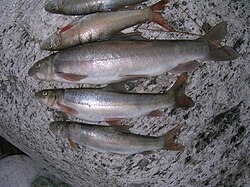| Schizothorax | |
|---|---|
 | |
| Schizothorax sp. | |
| Scientific classification | |
| Kingdom: | Animalia |
| Phylum: | Chordata |
| Class: | Actinopterygii |
| Order: | Cypriniformes |
| Family: | Cyprinidae |
| Subfamily: | Schizothoracinae |
| Genus: | Schizothorax Heckel, 1838 |
| Type species | |
| Schizothorax plagiostomus Heckel, 1838 | |
| Synonyms | |
RacomaMcClelland & Griffith, 1842 | |
Schizothorax is a genus of cyprinid fish found in southern and western China, through northern South Asia (Himalaya) and Central Asia, to Iran, with a single species, S. prophylax, in Turkey. [1] [2] [3] They are primarily found in highland rivers, streams and lakes, although a few species occur in lower-lying locations, like Lake Balkhash and lakes of the Sistan Basin. [1] [2] [4] [5] Their scientific name means "cloven-breast", from Ancient Greek schízeïn (σχίζειν) 'to cleave' and thórax (θώραξ) 'breast-plate' (see also thorax). The western species are typically referred to as marinkas from their Russian name marinka (маринка), while the eastern species are usually called snowtrout. Although they do resemble trouts in habitus this is merely due to convergent evolution and they are by no means closely related apart from both being Teleostei: Cyprinids are in the teleost superorder Ostariophysi, while trouts are in the superorder Protacanthopterygii. Their ancestors must thus have diverged as early as the Triassic, more than 200 million years ago.
Schizothorax is classified within the subfamily Schizotharcinae, the snow barbels, within the family Cyprinidae, the family which includes the carps, barbs and related fishes. [6] This grouping was formerly thought to include the mountain barbels now classified in the subfamily Schizopygopsinae. [2] [3]


